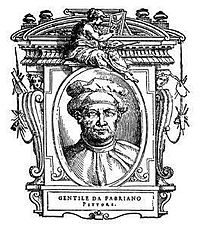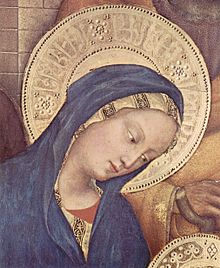Gentile da Fabriano
This article includes a list of general references, but it remains largely unverified because it lacks sufficient corresponding inline citations. (June 2019) |
Gentile da Fabriano | |
|---|---|
 Gentile da Fabriano, in a portrait by Giorgio Vasari | |
| Born | Gentile di Nicolò di Giovanni c. 1370 |
| Died | 1427 (aged 56–57) Rome, Papal States |
| Nationality | Italian |
| Known for | Painting |
Notable work | Adoration of the Magi |
| Movement | International Gothic |
Gentile da Fabriano[a] (c. 1370 – 1427) was an Italian painter known for his participation in the International Gothic painter style. He worked in various places in central Italy, mostly in Tuscany. His best-known works are his Adoration of the Magi from the Strozzi Altarpiece (1423), and the Flight into Egypt.
Life and career[]

Gentile was born in or near Fabriano, in the Marche. His mother died some time before 1380, and his father, Niccolò di Giovanni Massi, retired to a monastery in the same year, where he died in 1385. Little is known of his formation: one of his first known works, a Madonna and Child (c. 1395–1400, now in Berlin) shows the influence of the northern Italian late-Gothic painting.
By around 1405, Gentile da Fabriano was working in Venice. He painted a panel for the church of Santa Sofia, now lost; Jacopo Bellini worked perhaps in his workshop. Between 1408 and 1409, he painted a fresco (now lost) in the Doge's Palace depicting the naval battle between the Venetians and Otto III. In Venice he knew Pisanello and perhaps Michelino da Besozzo. He also produced commissions for other cities during this period, such as his Madonna and Child for a church in Perugia.
In 1410–1412 he painted one of his first masterworks, the Valle Romita Polyptych (now at the Pinacoteca di Brera). In 1410–1411 he was at Foligno, where he frescoed the Palazzo Trinci. In 1414 he moved to Brescia, at the service of Pandolfo III Malatesta, and painted the Broletto Chapel, a work now mostly lost. In the Spring 1420 he was again in Fabriano.

On 6 August 1420 he was in Florence, where he painted his famous altarpiece depicting the Adoration of the Magi (1423), now in the Uffizi and regarded as one of the masterpieces of the International Gothic style. His other works in Florence include the Quaratesi Polyptych (May 1425) and the Intercession Altarpiece. In June–August 1425 he was in Siena, where he painted a Madonna with Child, now lost, for the Palazzo dei Notai on Piazza del Campo. Until October he was in Orvieto, where he painted his fresco of the Madonna and Child in the Cathedral. In 1427 he arrived in Rome, commissioned by Pope Martin V to decorate the nave of the Basilica of St. John in Lateran, which was completed by Pisanello after his death.
Gentile is known to have died before 14 October 1427. He is commonly said to have been buried in the church now called S. Francesca Romana in Florence, but his tomb vanished; there is evidence, however, that he may be buried in the church of Santa Maria in Trastevere, in Rome, the place of his death.
He left no works in the Marche, except possibly a Madonna and Child (of uncertain attribution) in the Duomo at Sant'Angelo in Vado, near Urbino. He also left one painting in Venice.
Notes[]
References[]
- ^ "Gentile da Fabriano" (US) and "Gentile da Fabriano". Oxford Dictionaries UK Dictionary. Oxford University Press. Retrieved 1 June 2019.
- ^ "Gentile da Fabriano". The American Heritage Dictionary of the English Language (5th ed.). Boston: Houghton Mifflin Harcourt. Retrieved 1 June 2019.
- ^ "Gentile da Fabriano". Merriam-Webster Dictionary. Retrieved 1 June 2019.
- ^ Mack 2001, pp. 65–66.
Sources[]
- Mack, Rosamond E. (2001). Bazaar to Piazza: Islamic Trade and Italian Art, 1300–1600. University of California Press. ISBN 0-520-22131-1.
- Gentile da Fabriano e l'altro Rinascimento, catalogo della mostra (in Italian). Fabriano: Electa. 2006. Exposition lasting 21 April–23 July 2006.
- Marcelli, Fabio (2005). Gentile da Fabriano (in Italian). Silvana.
- De Marchi, Andrea (1992). Gentile da Fabriano. Un viaggio nella pittura italiana alla fine del gotico (in Italian). Federico Motta (published 2006).
- Łada, Justyna (2004). Obraz Maryi z Dzieciątkiem Gentile da Fabriano jako przykład typu Madonny (in Polish). Roczniki Humanistyczne KUL.
External links[]
| Wikimedia Commons has media related to Gentile da Fabriano. |
- Gentile da Fabriano biography-paintings-curiosity-publications
- Italian Paintings: Sienese and Central Italian Schools, a collection catalog containing information about Fabriano and his works (see index; plates 34-35).
- 5 paintings of Gentile da Fabriano
- Gentile da Fabriano at the National Gallery of Art, Washington DC
- 1370s births
- 1427 deaths
- People from Fabriano
- 14th-century Italian painters
- Italian male painters
- 15th-century Italian painters
- Gothic painters
- Catholic painters
